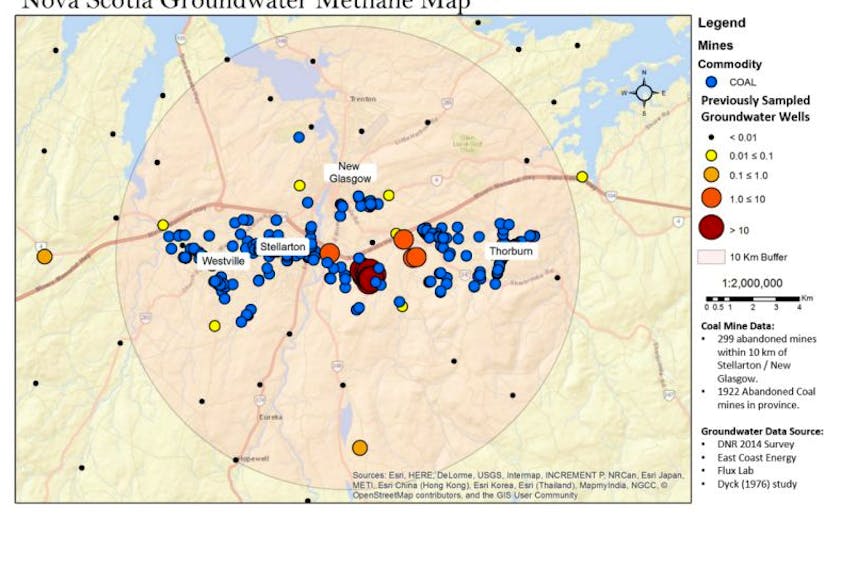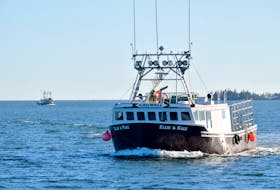And researchers want to find out whether those mines are emitting methane.
Researchers from several Maritime universities are looking for homeowners in the communities of Stellarton, New Glasgow, Thorburn, Westville, Hopewell and Eureka to participate in a study that will measure methane emissions in areas in close proximity to historically developed coal mines. As part of the Gas Seepage Project, researchers will conduct atmospheric, groundwater and soil gas testing around these abandoned sites.
Grant Wach, geologist with Dalhousie’s Department of Earth Sciences and a member of the GaSP team, said they’re seeking private well owners with drilled groundwater wells. He said water samples will be collected to measure pH, alkalinity, trace metals and methane. “Participation is completely voluntary and there will be no cost to the well owner.”
Methane occurs naturally in coal, making historical mines that weren’t constructed or decommissioned according to today’s environmental safeguards vulnerable to methane seepage into the atmosphere. Methane is a potent greenhouse gas that traps heat in the atmosphere.
In order to reduce greenhouse gases, Canada is working to cut methane emissions from various sources, including coal, oil and natural gas extraction operations. Wach said by 2025 Canada hopes to reduce methane emissions by 40 to 45 per cent from the oil and gas sector below 2012 levels.
He said 1,922 recorded mines exist in Nova Scotia. According to studies of abandoned mines in the United States, while methane emissions decline after mining activity ceases, abandoned mines can produce methane for an extended period of time. If they’re flooded, this occurs only for a few years.
Wach said in many cases abandoned mines are flooded, so they also want to test whether any methane is getting into the ground water. “Methane is not toxic at all, it’s not going to harm anybody’s health,” he said.
“Different types of coal have different levels of methane emissions, and currently there’s no record of methane emissions from different mining sites in Nova Scotia and New Brunswick,” explained Wach. “Our research aims to build an inventory of methane emission estimates from mines as well as other oil and gas extraction sites in both provinces.”
He said no one has systematically tested groundwater in these areas, and it’s hoped that the benchmarks found will help with meeting Canada’s target greenhouse gas emissions.
“We want to see the amount.”
On Friday at Dalhousie University, Halifax MP Andy Fillmore announced $482,000 in funding for the Gas Seepage Project, on behalf of federal Natural Resources Minister Jim Carr.
“Canadian universities are home to some of the best minds in the clean energy sector and they're keen to support our country's transition to a low-carbon future,” said Fillmore. “By investing in the work of these leading researchers, our government is taking meaningful climate action to ensure the accurate and effective measurement of methane emissions in our region.”
The project will assess methane emissions from old fossil fuel extraction sites, including coal mines, in Nova Scotia and New Brunswick. The funding was provided through the Energy Innovation Program, and is the first phase of a methane mitigation initiative in the Maritimes.
The research team involves professors and students from Dalhousie’s Department of Earth Sciences, St. Francis Xavier University, University of New Brunswick, University of Waterloo, and local industry partners.
“Together, and with this federal support, we’re building the scientific knowledge required to better understand how the fossil fuel extraction sites of our past are still affecting our atmosphere today,” said Ian Hill, associate vice president of research at Dalhousie. “This research will also lay the groundwork for similar methane emission assessments in other areas of Canada and the world.”
The study will be the first provincial-scale methane emissions inventory in the country.
Research assistant Fiona Henderson said anyone participating in the study will be given the results from their property, which will include alkalinity and trace metal tests. “It’s a good way to establish well water quality as well as any potential methane.”
She noted that while all of the results will be compiled for the report and released to the public, findings from individual locations will be kept private.
Anyone interested in participating in the study, can send an email to [email protected].









